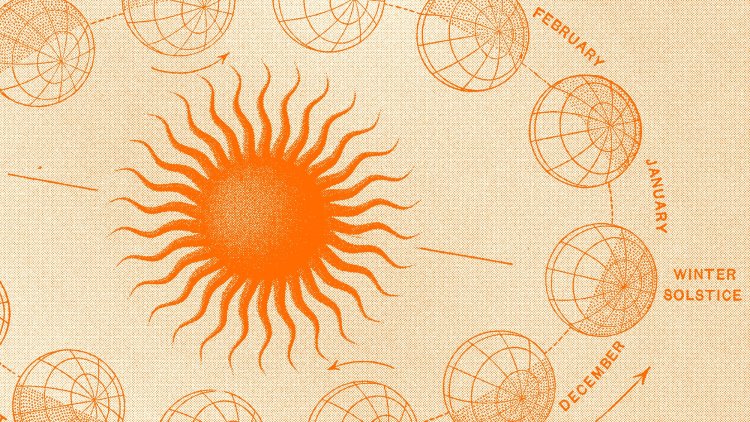A Nonreligious Holiday Ritual
The winter solstice is a pristine time for the simple act of noticing.

This is an edition of Time-Travel Thursdays, a journey through The Atlantic’s archives to contextualize the present and surface delightful treasures. Sign up here.
Updated at 4:22 p.m. ET on December 19, 2024.
Low winter sun casts slanted light, a specific hue that’s at once happy and sad—highly fitting for this time of year. Nearly every city-dweller I know clings to the fleeting moments of gratifying glow during the final dark days of the calendar.
This year, the winter solstice will arrive at 4:20 a.m. ET on Saturday, December 21. Because of the tilt of the Earth’s axis, those of us in the Northern Hemisphere will find ourselves tipped away from the sun. A day later, we’ll begin inching back toward it. Whereas the summer solstice is built for revelry—short sleeves, sizzling barbecues, the thunk of an icy cooler—the winter solstice is a quieter, more reflective time. Maybe you have no plans to mark the solstice beyond staying inside and letting the short day skate by (understandable). But for anyone inclined to venture outside, the solstice is a pristine time for the simple act of noticing.
In 1894, the poet Edith M. Thomas published an essay in The Atlantic titled “From Winter Solstice to Vernal Equinox.” The opening sentence is particularly evocative. “My first glimpse of the morning was through a loophole of the frosted window pane,” Thomas writes. “I saw the morning star and a light at a neighbor’s, both of which struck out a thousand sparkles on the frosted glass. I was reminded of saline flakes and spars in a white cavern suddenly illuminated by a torch.” Thomas keeps her senses dialed into the present, heightening her powers of observation: “Looking off to the distant woods, my attention was attracted by the mysterious play of two wind-blown smoke-plumes proceeding from farmhouse chimneys.”
Commemorating the solstice is an ideal ritual for those of us who feel pulled toward upholding seasonal traditions even if we’re ambivalent about organized religion. In December 1930, an unnamed Atlantic contributor wrote: “Our Christmas puddings and cake, like our gaudy tree, our holly wreaths and mistletoe, are part of the symbolism that unites us not only to our living fellows, but to all the human beings who have celebrated the winter solstice with feasting and mirth.” The writer affectionately refers to themselves as a “heathen,” given that they attend mass only once a year—a midnight service on Christmas Eve—and do not subscribe to an established religion. Of course, even without any religious institution, nodding at the solstice can be a way to tap into your spiritual side.
Nearly 100 years later, in an Atlantic section called The Conversation, two readers, Ruth Langstraat and Roxanne WhiteLight, shared their tradition of exchanging writing as a gift: “Several years ago, my wife and I felt we needed a better way to celebrate or mark the winter season of change. We had become so tired of the materialistic push that feels like such a part of that time. We now celebrate ‘Turning’ during the 12 days from the solstice until the new year. Each year, we decide on a theme and 12 elements of that theme … Then we each write a poem following the simplest form of a cinquain, a five-line stanza. And we read those poems to each other.”
Winter is the perfect time to find a comforting lamp and put pen to paper, but there’s no mandate that what you write has to be joyful. The poet Louise Glück captured the stark Northeast essence of this time of year with just a few simple phrases—“spiked sun,” “bone-pale”—in her 1967 poem “Early December in Croton-on-Hudson,” published in The Atlantic. In the poem, Glück describes the sight of a recent snow fastened “like fur to the river.” Tragically, as my colleague Zoë Schlanger recently reported, snow this time of year is now an anomaly for millions of Americans: Our winters are getting warmer and wetter.
But they’re still dark as ever. Perhaps with so much dismal winter(ish) reality to contend with, it’s time to seriously consider my colleague Charlie Warzel’s argument that we should leave our Christmas trees up until March. In 2022, Charlie wrote of the January emptiness symbolized by his recently kicked-to-the-curb tree: “When I stare at this hole, I begin to feel as if a light has gone out in the world.” He went on: “There is no reason to embrace the new year in darkness. It is time we institute a new practice of keeping up our trees and our lights while we ride out the winter months. Normalize prolonged festivity!”
Fighting that darkness with light is really what choosing to recognize the solstice is all about. In addition to all of the usual Christmas songs, I make a point of listening to “Snow Is Falling in Manhattan,” by Purple Mountains, from the final project of David Berman. As my colleague Spencer Kornhaber wrote in one of two tributes to the songwriter after he died in 2019, “Berman sketched a winter evening in New York City as a beautiful apocalypse.” Such a stark juxtaposition—beginning and end, up and down, happy and sad, light and dark—is part of the spirit of December 21. As Berman sings:
Snow is falling in Manhattan
Inside I’ve got a fire crackling
And on the couch, beneath an afghan
You’re the old friend I just took in.
This article originally stated that the solstice is related to the Earth’s distance from the sun; in fact, it is caused by the tilt of the planet’s axis.
What's Your Reaction?




















